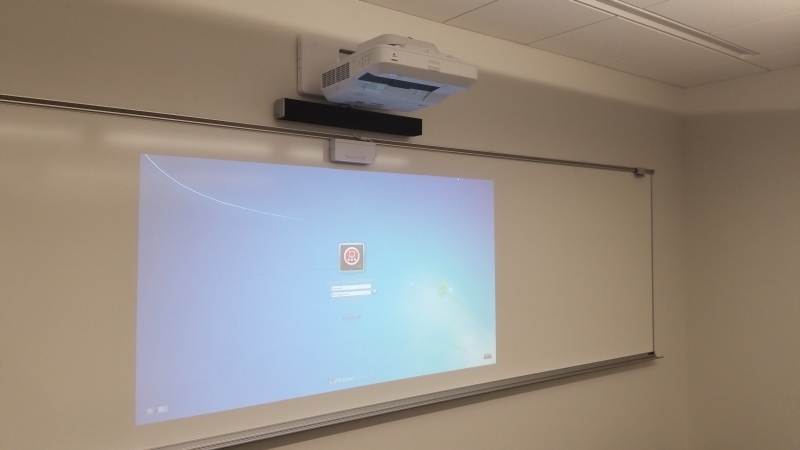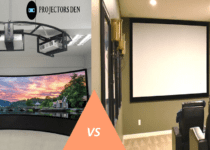Disadvantages Of Projector In The Classroom
After Covid-19, projectors have become very important in education. They help teachers show things on a big screen, which makes learning more fun and interactive. You can find projectors in many places, like small businesses, big companies, and even in people’s homes for watching movies.
But, we should also know that while projectors have a lot of good points, they also have some disadvantages when used in classrooms.

Disadvantages Of Projector In The Classrooms
A discussion among educators is ongoing, with some asserting that projectors can be a source of distraction for students, while others argue that projectors aid in student concentration.
To provide you with a comprehensive understanding, we have outlined a few of the drawbacks associated with having a projector in the classroom below.
1. Image Quality
The clarity of projector images may be influenced by the gap between the projector and the screen. If the projector isn’t positioned at the right distance, the image might appear warped or unclear. Additionally, the quality of the screen plays a significant role in image quality, emphasizing the importance of using a high-quality screen for optimal visual results which can be quite expensive.
2. Maintenance
To keep projectors operating properly, they demand routine upkeep. The projector’s lamp should be replaced every few years, depending on how often it’s used. Regular cleaning of projectors is also essential to prevent the accumulation of dust, which can have a negative impact on the quality of the projected image.
3. Brightness
One of the main downsides of projectors is that they work best in dark rooms. They’re not as bright as TVs or computer screens, so using them in well-lit places can be tricky. The amount of light around you also affects how well they work, which means they might not be great for outdoor events or during the daytime.
4. Additional Cost For The School
Introducing a projector in every classroom can lead to extra expenses because good-quality projectors come with a higher price.
It also adds to the school’s maintenance costs as projectors require regular upkeep and occasional repairs. Additionally, screens for each classroom will be necessary.
5. Increased Electricity Bills
To display images in daylight, we require projectors with higher lumens, which consume more electricity. So, opting for brighter projectors leads to an uptick in electrical costs.
Hence, if you decide to set up high-lumen projectors in all classrooms and they run for extended hours, this will result in a higher electricity bill for the school.
6. May Require an external speaker
In a classroom filled with numerous students, you may find it necessary to supplement the projector with an external speaker.
The built-in speakers of projectors are often not sufficiently loud to reach the students in the back rows, especially if the projector has standard speakers. Additionally, for projections covering long distances, those seated in the front might struggle to hear.
Consequently, if your aim is to ensure that everyone in the class can hear the content being displayed on the screen, an external speaker will be essential.
7. Can Harm Student Eyes
The light emitted by the projector is quite intense and can be harmful to students’ eyes if they gaze at the screen for extended periods.
This projector’s brightness can also trigger headaches for some students and impact their ability to concentrate.
Moreover, many students set up projection systems in their dorm rooms, which can weaken their eyesight due to continuous viewing of content on a wall or screen.
8. Projectors can be noisy
Projectors can be really noisy, and this noise can be a problem in a classroom. It can distract students and make it hard for teachers. To make it quieter, you can use an amplifier or a white noise generator. Some teachers have used white noise generators, and fans can help reduce the noise too.
9. Projector Needs a power supply
When using a projector, it’s essential to ensure you have access to a power source. This means you need to have a power outlet available in your classroom or wherever you plan to use the projector.
Furthermore, if you’re using a projector in your classroom, it’s crucial to confirm that your power source matches your specific projector’s requirements. Most projectors come with a unique power cord that may not work with power sources designed for different projectors.
In the past, many teachers encountered issues because they were using projectors that did not match their available power supplies.
10. Projectors Can Create Glare
When utilizing a projector for educational purposes, it’s crucial to take into account the distance and angle of the projection to prevent casting a strong light directly into students’ eyes. A major drawback of projectors is the potential for glare.
In a classroom setting, it’s important to position the projector in a way that avoids shining light directly onto the students’ faces. As a general guideline when using a projector, consider placing it approximately 18 inches from the wall and at an angle that prevents direct illumination of the students’ faces.
Conclusion
Projectors can offer significant benefits in the classroom, yet it’s important to weigh their potential drawbacks as well.
Therefore, if you intend to incorporate a projector into your classroom, be sure to carefully take into account all the factors mentioned above.
Related Posts:


